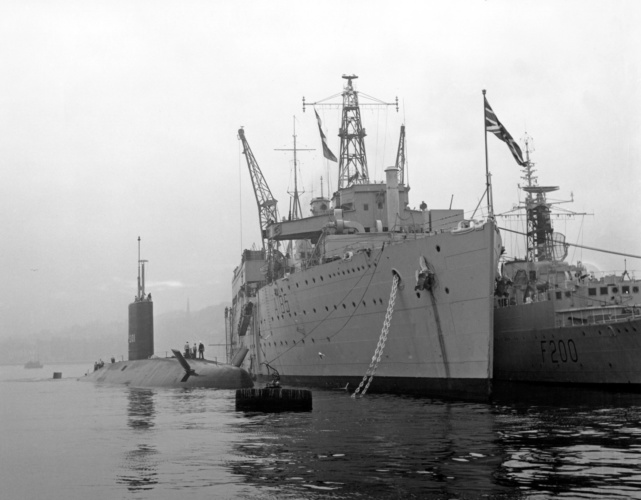In October 1960 Queen Elizabeth II continued a tradition that began in Barrow-in-Furness in 1886 and continues to this day at a site that is only one of a handful worldwide capable of building nuclear submarines.

In 1886 the steam powered Abdül Hamid launched in Cumbria before entering service with the Ottoman Navy and by 1901 the first Holland-class submarines were launched from the site for the Royal Navy.
On Trafalgar Day, 1960, the UK saw the launch of its first nuclear-powered submarine and it would bear a name as steeped in navy tradition as the Barrow site itself.
She was ninth ship of the Royal Navy to bear the name Dreadnought, the first having fought against the Spanish Armada and the fifth present at Trafalgar. The seventh was one of the first iron-clad turret ships, and the eighth was the first large warship to have turbine machinery.
READ THE ORIGINAL ARTICLE HERE
HMS Dreadnought was unique to the Royal Navy as it was the first built with nuclear propulsion but it was several years behind the US whose own navy had no fewer than 56 nuclear powered warships built, under construction or authorised, including 53 submarines.
Launched in 1954, the world’s first nuclear powered naval vessel - USS Nautilus - travelled 62,000 miles – mainly submerged – before her reactor core was changed.
“By then she had proved conclusively that the nuclear power plant had eliminated the two main drawbacks of the underwater vessel - the need frequently to surface and her poor mobility submerged,” The Engineer said.
According to our predecessor, this success prompted the US Navy to combine a nuclear power plant with a more efficient type of underwater hull - known as tear-drop which, in an experimental diesel-electric drive submarine, ‘gave a remarkably high submerged speed for as long as her battery lasted.’ This led to USS Skipjack which commissioned in 1959 and provided the prototype for HMS Dreadnought.
“As originally planned, the Dreadnought was to have been fitted with a British designed and built nuclear reactor, but in 1958 an agreement was concluded with the United States Government for the purchase of a complete set of propulsion machinery of the type fitted in the Skipjack,” said The Engineer. “This agreement has enabled the submarine to be launched far earlier than would have otherwise been possible.”
The supply of this machinery was made under a contract between the Westinghouse Electric Corporation and Rolls-Royce, the latter supplied also with design and manufacturing details of the reactor. This allowed Rolls-Royce to set up a factory in the UK to manufacture similar pressurised water type reactor cores, which drove a single shaft through steam turbines.
“Almost every electrical and mechanical part of the propulsion machinery is installed in duplicate so as to minimise the inconvenience of breakdowns,” our predecessor said. “In addition, every control feature of the power plant and of the ship has been duplicated. These innovations will ensure an extremely high standard of reliability which, combined with the need to refuel at only very long intervals, will give her the ability like other nuclear submarines to undertake patrols of particularly long endurance at continuous high underwater speeds.”
The Engineer’s reporter added: “With a length of 266ft, a beam of 32ft and a surface displacement of about 3,500 tons, the Dreadnought will have a hull of British design both as regards structural strength and hydrodynamic features, although the latter are based on the pioneering work of the US Navy.
“From about amidships aft, the hull lines will closely resemble the Skipjack so as to accommodate the propulsion machinery. The forward end of the ship is wholly British in concept. In the Control Room and the Attack Centre the instruments are fitted into consoles. She will be fitted with an inertial navigation system and with means of measuring her depth below ice.”
Dreadnought’s inertial navigation system provided accurate navigation under water, was completely automatic and ‘invulnerable to detection or jamming and independent of ground-based aids’.
“It consists essentially of an assembly of very accurate gyroscopes and accelerometers with associated servo-amplifiers, arranged and inter-connected to form an accurate gyro-compass with a stabilised horizontal platform,” said The Engineer. “Her primary role is as a submarine hunter killer for which purpose she will be equipped with the latest developments in underwater weapons and detection.”
The Engineer added that specific details about Dreadnought’s speed and performance were off-limits, but it was noted that she probably handled and controlled as well as Skipjack as both vessels had the same hydro-dynamic features.
“The Skipjack is unofficially credited with a submerged speed of over 40 knots,” said The Engineer. “This means that she literally flies through the water.”
The Dreadnought was commissioned into service in 1963 and served until 1980. Her name will be kept alive by four Dreadnought Class submarines, the Royal Navy’s next generation Trident submarines that are slated to be built in Barrow.










McMurtry Spéirling defies gravity using fan downforce
What a fun demonstration. I wonder if they were brave enough to be in the car when it was first turned over. Racing fan cars would be an interesting...